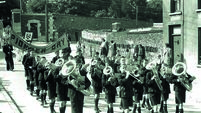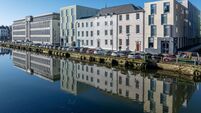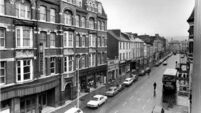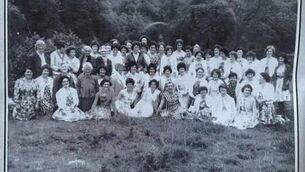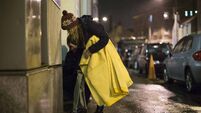Throwback Thursday: Ex-pupils of Cork school wept at my teacher dad’s funeral
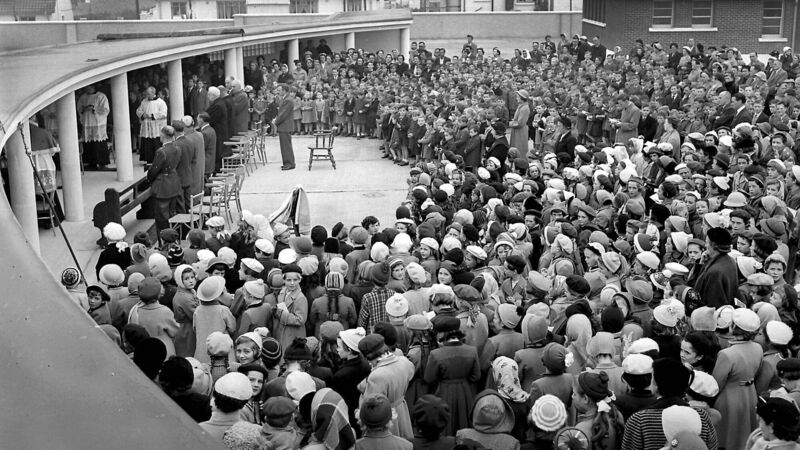
Crowds gather as the new Glasheen School is officially opened and blessed by Dr Cornelius Lucey, Bishop of Cork, in 1955.
READER Mary Holly looks out for Throwback Thursday every week and after the most recent one, she wrote to say: “Ah Jo, the column that keeps on giving!”
The first photo accompanying that column, she explained, was of two little lads arriving at Glasheen Boys N.S. on October 28, 1955.
“I don’t know who the boys are, but the house in the background is my mother’s old family home,” said Mary.
“She was Girlie O’Donovan before her marriage to dad, Joe Holly, from Wilton Road. Dad was a teacher and came to Glasheen N.S. after their marriage, around 1946 I think.”

She recognised some of the teachers who were mentioned by Tim Morley in his article on his time at National School (Glasheen Boys) last week.
“I am glad he confirmed that Dad was not a one to employ the ‘bata mor’,” said Mary.
“When Dad died, aged 95, there were past pupils at his funeral, some of whom were even in their seventies. They were anxious to pay their respects and express their gratitude for his kindness.
“My sisters and I still talk about one middle- aged man who just stood at Dad’s coffin and cried. We didn’t know him but obviously Dad had had a profound effect on him.
“This is quite a contrast to listening to Roger Daltrey of The Who on Tommy Tiernan’s programme recently, as he related how he was told by his head teacher, ‘You will never amount to anything’.”
Just as well that Daltrey didn’t take the advice to heart!
Kevin Martin has written to say that a few weeks back, Tom Jones, formerly of Shandon Street, but now living in Key West, Florida, mentioned a good friend, Frankie Martin who played in Blarney Street C.B.S. Pipe Band.
Kevin wants to point out that he is Frankie Martin’s nephew.
“My father, Eddie Martin (now deceased) was Frankie’s older brother. They lived on St Rita’s Avenue, just up the hill from Blarney Street.”
Kevin expressed a desire to talk with or write to Tom Jones, and so learn more about his father and uncle growing up on Cork’s northside. That was a request we couldn’t refuse, so we got in touch with Tom right away, and he, bless him, didn’t delay in replying.
“Just read your recent Throwback Thursday column. As always, I have enjoyed it and look forward to reading it here in the U.S.A. every week.
"Thank you for your recent enquiry re Frankie Martin; I have now replied to him in person. Jaysus, how many of us are still alive?”
Recent topics may also, Tom suggests, have opened a vein of contention for people to reminisce on their young days at national schools or Christian Brothers in Ireland, in particular with regard to corporal punishment.
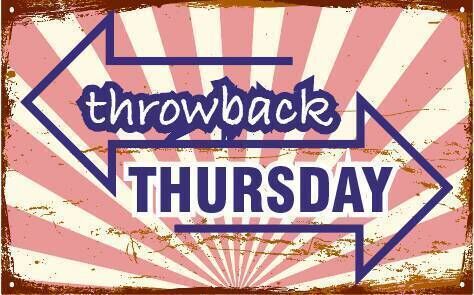
“I seem to detect here from those who reply, that those who went on to Pres or Christians, seem to have more acceptance of corporal punishment as an educational form of teaching as those who did not go on to these top schools,” suggested Tom.
“Interesting to say the least. Perhaps there is a sociological study in prospect there for some student, but I’m not sure if I can concur with that acceptance of such punishment as necessary.”
Tom says he can only speak of his own experiences with primary, not secondary, education in Ireland, and to this day remains appreciative of the Christian Brothers as an entity of dedication and effort to education here.
Yet, he stresses, he still questions their methods of application in 1950s and early 1960s Ireland, not so much in terms of alleged brutality by the Brothers (although such practice should never be ignored), but rather in terms of their blind indifference to their pupils’ gestalt (ie, the effect on the whole person, not just on the educational aspect).
Tom himself has witnessed both the physical, and psychological, effects of such behaviour.
“While I have had a reasonably successful life and career, eventually attending Cornell University in New York, I can still recall others who suffered under the harsh tutelage of those times now long past.”
On a separate note, says Tom, he certainly enjoyed the articles on the Savoy Cinema. “I have great memories of that place myself, as a child.”

Yes, many of you have fond recollections of the Savoy, and we were pleased to hear from John McSweeney, author of The Golden Age Of Cork Cinemas, which we mentioned last week.
John acknowledges that the photo of Fred Bridgeman at the organ, which we featured (taken by Richard Mills while still a schoolboy, back in 1965) was a rare find indeed.
“There have been a few other posed shots of him sitting at the organ,” says John, and thoughtfully gives a link to them on his Facebook page: https://www.facebook.com/thegoldenageofcorkcinemas/photos/1557484460998882 and https://www.facebook.com/thegoldenageofcorkcinemas/photos/492797127467626
Keenly interested as he is in the history of our city’s picture houses, John was wondering if the time was ripe for a retrospective on the Coliseum.
“The building is now scheduled to be converted into a hotel, but it was the first custom-built cinema in the city, opening back in 1913,” he said.
“In all my years researching Cork cinemas, I never managed to discover a photo of its interior, but I always hold out hope that one may exist in a private collection. Perhaps you might ask your readers if they are aware of one?”
That we will do, right now, John. Anybody out there have an early indoor shot of the Coliseum? If you recall, we mentioned a while back that it was occasionally used in the 1950s as a theatre, certainly by the Cork Grand Opera Group, and we would love to know more about that unexpected side of its life too.
John says that he is looking forward to reading future instalments on cinema as he is in the initial stages of planning another book on Cork, and would love to hear some of the stories about our grand city.
“I’m also planning on launching Cork Cinema Tours. Hopefully, locals and tourists may be interested in getting guided tours of the locations of the old cinemas.”
Well now, wouldn’t that evoke some wonderful memories of younger days, the pennies and sixpences clutched in hot little hands, the scurrying up stairs to the ‘gods’, the breathless anticipation as the long-awaited big feature started?
And then coming out into the evening light, dizzy and dazzled, instinctively recreating the cowboy chases, the comedy fights, the dramatic scenes right there on the pavement under the amused eyes of passers-by?
Tom Jones shared his own memories of the Savoy.
“That was, to me, the grand old dame of Cork cinema. It was more than just a place to go see a movie. It was an event. With not only the full-length feature film, but also a ‘B’ film beforehand, plus shorts, extras, and a couple of trailers for coming attractions, it offered a full afternoon or evening’s entertainment.”
Tom can still recall the imposing main entrance with the canopy overhanging the pavement, the lettering advertising what was showing, the neon lighting illuminating the upper façade after dark.
“You came up three steps from the pavement, got your first view of the immense foyer, then two more steps to find yourself in front of the ticket kiosks, one on either side of the marble floor.
“Before you was another set of stairs, at the top of which stood the dark mahogany concession stand, displaying a treasure trove of tasty delights for those who had the money.
“Just beyond that was a set of stairs on each side, rising to join together to form a landing at the entrance to the balcony level, known colloquially in Cork as De Gods. From this position also you could walk forward past the dining tables of the restaurant to arrive at the doors at the back of the auditorium.
“But to the child, that was me, the best entrance was just beyond the ticket kiosk on the right as you entered the building. From there you could walk down some stairs, down a long corridor with portraits of film stars and movie posters decorating the walls, then up some more steps to find yourself midway in the downstairs auditorium.
“Now you could see the red stage curtain divided into concertinaed hanging semi-circles. In front of the stage surround, which was quite elaborate, in and of itself, was a baluster railing enclosing what resembled an orchestra pit. From here Fred Bridgeman would rise majestically during the intermission, playing the organ as he came.
“While he played, the words of the song appeared on the screen and the audience would sing along happily, and in unison by following along, with the bouncing ball picking out each word.”
Tom says he always thought that Bridgeman played only on weekend nights and would like to hear other memories.
From our own recollection, we certainly remember him in full musical energy at matinees, but can’t be sure if that was only on Saturdays or all the time. Let’s hear from others, please!
Tom points out that he has, in his lifetime, been to many legendary cinemas, including those on Hollywood Boulevard, but still takes pride in the fact that he had attended Cork’s Savoy cinema in his time.
“Maybe I am biased, but I feel that the Savoy will always have a special place in the history of Cork and its people,” he said.
“The part it played in the Film Festival: I can hardly have been the only small boy who stood outside at night to see what unutterably glamorous film stars might arrive.
“It’s sad that it could not continue on as a viable financial enterprise, did not survive the changing times. I am also sad that, allowing for certain modifications, and upgrading, the structure, the whole wonderful effect, from the grand entrance and foyer, to the restaurant and the auditorium, could not have been preserved in its original form. Surely it would be a great asset to Cork as an entertainment complex.”
You would think so, Tom, you would think so.
Mr Jones has two final queries: “Does anyone recall the curving plate-glass windows outside the Pavilion Cinema, which had a more aesthetic frontage, than the Savoy, albeit without a canopy? And was the Savoy the only cinema in Cork to have a canopy outside?”
Well, the elegant frontage of the Pavilion, you will be glad to know, Tom, has survived fairly well, and is now home to Golden Discs.
As regards canopies – both the Palace and (we think) the Capitol had these too, but perhaps not as convenient as the Savoy for the age-old meeting place of young people ‘doing Pana’ on Saturdays.
Have you special memories on this or other topics? Let us hear them. Email jokerrigan1@ gmail.com. Or leave a comment on our Facebook page: (https://www.facebook.com/echolivecork)
